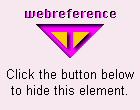DHTML Lab: Cross-Browser Visibility Transitions; Navigator Transitions I
 | Cross-Browser Visibility Transitions
|
|||||||||||||||||||||||||||||||||||||||||||||||||||||||||||||||||||

|
Horse of a Different Color Dept.Always keep in mind that in this column, we are creating a positioned element transition library. To help us, we are using the Explorer built-in reveal transitions only for the purpose at hand. The Explorer transitions have many more uses. With that repeated, let's move on to Navigator 4. We will build transitions pixel-by-pixel using a completely different logic than that used for Explorer. Our first task is to outline the logic necessary:
The ScriptIn our external script, therefore, we first redirect Navigator 4 to doTransNS(): function doTrans(el,transNo,dur) {
whichEl = eval(el);
transNo = parseInt(transNo);
arHidden = new Array(1,3,14,16);
if (IE4) {doTransIE(whichEl,transNo,dur)}
else {doTransNS(whichEl,transNo,dur)}
}
The remainder of the script takes this form, following the logic set out above: function doTransNS(whichEl,transNo,dur) {
general transition variables declared here
switch (transNo) {
case 0:
transition type-specific variables
declared here
case 1:
transition type-specific variables
declared here
case 2:
transition type-specific variables
declared here
.
.
.
case 23:
transition type-specific variables
declared here
}
transTimer = setInterval(functionName,interval)
}
function zero() {
transition 0 (Box-In) code goes here
}
function one() {
transition 1 (Box-Out) code goes here
}
function two() {
transition 2 (Circle-In) code goes here
}
.
.
.
function twentythree() {
transition 23 (Random) code goes here
}
function hideIt() {
code that returns element to original
size goes here
}
Notice that every transition is a different function. This is necessitated by the use of setInterval(), which calls a function repeatedly until the transition is complete. So, let's build the Navigator script. | |||||||||||||||||||||||||||||||||||||||||||||||||||||||||||||||||||
Produced by Peter Belesis and
All Rights Reserved. Legal Notices.Created: Apr. 28, 1998
Revised: Apr. 28, 1998
URL: https://www.webreference.com/dhtml/column19/transNSone.html


 Find a programming school near you
Find a programming school near you